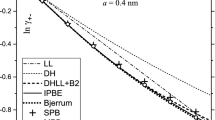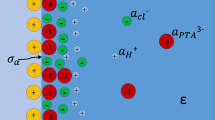Abstract
We discuss several interrelated single-ion thermodynamic properties required to calculate the liquid junction potential Ψ between two solutions of the same binary electrolyte. According to a previously reported molecular theory of nonuniform electrolyte solutions in nonequilibrium, Ψ is determined by the transport numbers of the ions, and by the second moment coefficients H (2)α of the charge densities around the ions. The latter may be viewed as the single-ion contributors to the second moment condition of Stillinger and Lovett. For a solution of a single binary electrolyte, we relate the H (2)α (R) to the derivatives of the single-ion activity coefficients γα with respect to the ionic strength. In the light of these results, we examine, in some detail, the role played by the specific short-range interionic interactions in determining Ψ. We investigate this matter by means of integral equation calculations for realistic models of LiCl and NaCl aqueous solutions in the 0–1 mol-dm−3 range. In addition to the hypernetted-chain (HNC) relation, we perform calculations under a new integral equation closure that is a hybrid between the HNC and Percus–Yevick closures. Like the HNC approximation, the new closure satisfies the Stillinger and Lovett condition. However, for the models considered in this study, the two closures predict different dependence of the H (2)α and of Ψ on the specific part of the interionic interactions.
Similar content being viewed by others
REFERENCES
F. O. Raineri and H. L. Friedman, J. Chem. Phys 94, 6135 (1991).
H. S. Harned and B. B. Owen, The Physical Chemistry of Electrolyte Solutions (Reinhold, New York, 1950); (b) G. Milazzo, Electrochemistry (Elsevier, Amsterdam, 1963); (c) G. Kortüm, Treatise on Electrochemistry (Elsevier, Amsterdam, 1965); (d) J. Goodisman, Electrochemistry: Theoretical Foundations (Wiley, New York, 1987).
H. L. Friedman, A Course in Statistical Mechanics (Prentice-Hall, Englewood Cliffs, 1985).
F. H. Stillinger and R. Lovett, J. Chem. Phys. 49, 1991 (1968).
C. W. Outhwaite, in Statistical Mechanics, A Specialist Periodical Report, Vol. 2, (The Chemical Society, London, 1975).
D. J. Mitchell, D. A. McQuarrie, A. Szabo, and J. Groeneveld, J. Statistical Phys. 17, 15 (1977).
H. van Beijeren and B. U. Felderhof, Mol. Phys. 38, 1179 (1979).
H. L. Friedman, F. O. Raineri, and H. Xu, Pure Appl. Chem. 92, 76 (1991).
H. L. Friedman and W. D. T. Dale, in Equilibrium Techniques, B. J. Berne, ed. (Plenum, New York, 1977).
P. Sloth, Chem. Phys. Lett. 164, 491 (1989).
P. G. Kusalik and G. N. Patey, J. Chem. Phys. 86, 5110 (1987).
J. G. Kirkwood and F. P. Buff, J. Chem. Phys. 19, 774 (1951).
D. A. MacInnes, J. Am. Chem. Soc. 37, 2301 (1915); (b) D. A. MacInnes, The Principles of Electrochemistry (Dover, New York, 1961).
T. Morita, Prog. Theor. Phys. 23, 829 (1960); T. Morita and K. Hiroike, Prog. Theor. Phys. 23, 1003 (1960).
C. G. Gray and K. E. Gubbins, Theory of Molecular Liquids, Vol. I (Oxford, New York, 1984), Appendix 5B.
G. Stell, J. Statist. Phys. 78, 197 (1993).
H. Xu, H. L. Friedman, and F. O. Raineri, J. Solution Chem. 20, 739 (1991).
P. S. Ramanathan and H. L. Friedman, J. Chem. Phys. 54, 1086 (1971).
P. J. Rossky and W. D. T. Dale, J. Chem. Phys. 73, 2457 (1980).
P. J. Rossky and H. L. Friedman, J. Phys. Chem. 84, 587 (1980).
E. C. Zhong and H. L. Friedman, J. Phys. Chem. 92, 1685 (1988).
L. Pauling, The Nature of the Chemical Bond, 3rd edn. (Cornell University Press, Ithaca, New York, 1960).
D. G. Miller, J. Phys. Chem. 70, 2639 (1966).
Author information
Authors and Affiliations
Rights and permissions
About this article
Cite this article
Raineri, F.O., Friedman, H.L. & Stell, G. Single-Ion Contributions to Activity Coefficient Derivatives, Second Moment Coefficients, and the Liquid Junction Potential. Journal of Solution Chemistry 28, 463–488 (1999). https://doi.org/10.1023/A:1022618229925
Issue Date:
DOI: https://doi.org/10.1023/A:1022618229925




